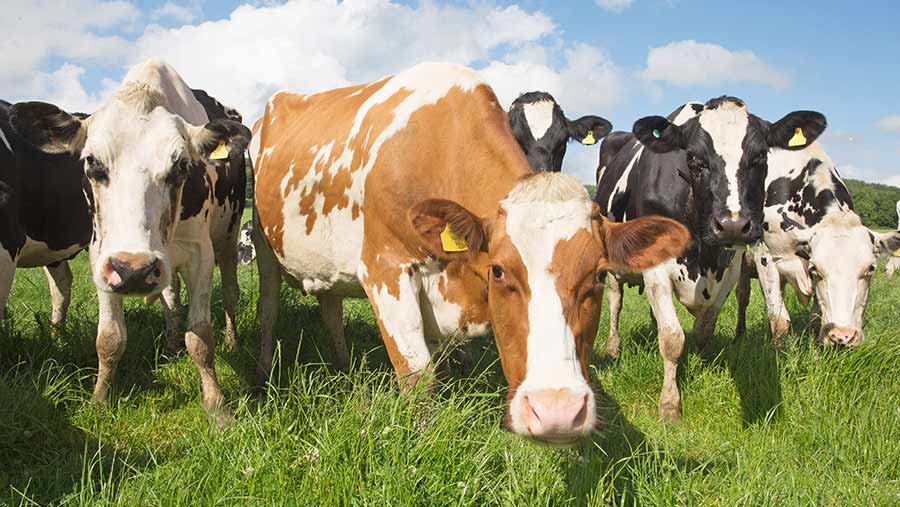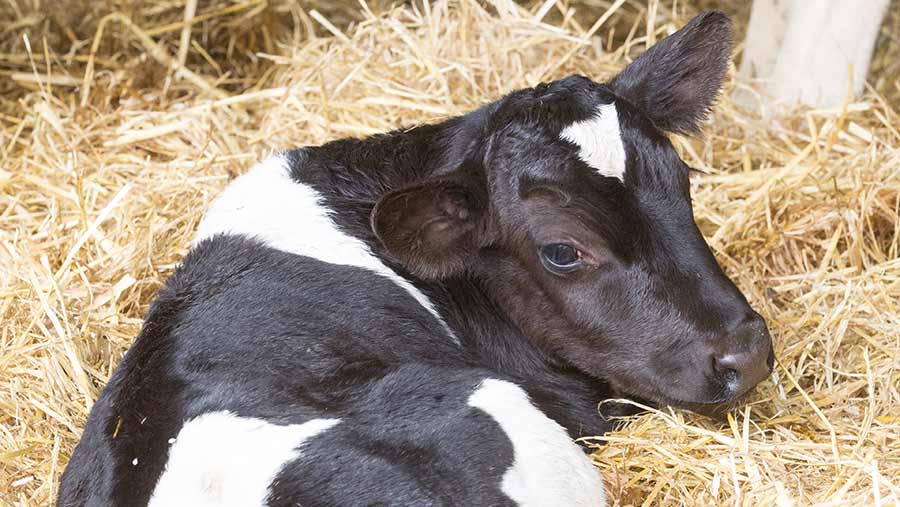Fertility advice for autumn-calving dairy herds
 © Tim Scrivener
© Tim Scrivener Practising farm vet Dave Gilbert, who has 13 years’ experience working with block-calving herds, says the first steps are working out when you want to start, how long you want to calve for, what the desired output is and how much input is needed.
Thinking about the timing of calving can be particularly important with staffing – calving in August might be harder with staff who want time off for school holidays, for example. Therefore, it is important to pick a time that works for the farm and the team.
Likewise, a shorter calving period can be easier in terms of work-life balance, but it does require more resources for that window, so might not suit all systems.
Ultimately it comes down to the income you need from the system and what works financially and logistically on your farm
As part of a series of events run by AHDB Dairy, Mr Gilbert has been advising autumn-calvers on how to improve fertility in their herds.
The key areas that need to be focused on are:
Preparing for mating
1. Transition management
Transition management is hugely important to the health and profitability of cows. Measures of transition management, which indicate whether the breeding season will be easier or more difficult, include the levels of:
- Milk fever – metabolic disease caused by low calcium levels in the blood
- Retained foetal membranes – held cleansings
- Metritis – inflammation of the uterus caused by infection
- Ketosis – metabolic disease caused by negative energy balance
Target: Below 5% on all of the above indicators – ideally 2% or less.
Action: Above 5%, respond and attend to the problems.
2. Body condition
The fertility year starts at 200 days in milk, which is the point that body condition score (BCS) of lactating cows will have stabilised. This is the point at which body condition scoring should begin and then it should be measured:
- Pre-calving
- Pre-mating
- At the end of mating
- Pre dry-off
Target body condition score |
|
|
Drying-off |
3.0 |
|
Calving |
3.0-3.5 |
|
First service |
2.0-2.5 or above |
|
Mid-lactation |
2.5-3.0 |
|
Source: SRUC Technical Note TN587 2007 |
|
The aim should be to get to the optimum body condition score at drying-off and then hold it across the dry period so cows are calving at optimum BCS.
Target: 85% + of cows at the right body condition score for that point in the season. With no more than 10% either side.
Do not use average body condition score for the herd – this number could look fine on paper but actually be calculated from extremes of BCS either end of the scale.
Action: If not hitting the BCS targets there are three options:
1. Segregate a group that are not at the right BCS and manage them differently.
2. Leave as one group and treat differently, for example varying in-parlour feeding.
3. Reduce demand on cows not at the right BCS – for example, by reducing milking frequency.
3. Get cows settled
Change induces stress in cows and stress reduces conception rate and follicular quality. Therefore, it is key to get cows settled in the breeding environment for several weeks ahead of mating.
Even if grass is growing well, it is important to avoid the temptation to leave cows out longer and graze right up until breeding before bringing them into the shed.
Action:
- Avoid any management or feed changes three to four weeks before breeding. Changes in this time will affect conception rates in the first cycle.
- Manage grass differently, instead of leaving cows out too late, or move the grazing block, depending on system and seasonality payments.
Uterine health
Because the egg is developing six to eight weeks before breeding, an infection will affect the survivability and quality of that egg, so it is key uterine health is looked after.
A high proportion of infected cows won’t show discharge, so checking uterine health and treating “dirty” cows is important.
There are various ways to check for metritis, but the assessment is key and it is worthwhile checking every cow.
One way to make this process faster and easier is by using the Metricheck tool for internal assessments rather than a clean, gloved hand.
The tool, available from various online sites, is smaller than a human hand, so can cause less trauma for heifers and can speed up checking, letting you assess 200 cows an hour.
Using tail tape to mark cows that have been checked and cleared or treated can help identify individuals that may need follow-up checks.
Discharge should be classified from one to five:
1. Dead clear slime
2. Clear with flecks
3. Less than 50% white
4. More than 50% white
5. Brown, putrid
Anything from 2-5 will delay the heifer or cow getting in calf.
Target: A score of 1.
Action: Treat if the score is anything from 2-5.
Getting cows served
1. Environment
It is important to consider the cow’s environment for the planned start of mating (PSM).
Cows will avoid bulling and heats may be harder to detect with conditions such as:
- Slippy floors – poor concrete, icy weather
- Lack of space – tight passageways
- Dark areas
Action: Check and improve environment where possible. Review each year as weather changes.
2. Heat detection
Starting detection early and keeping good records of heats is key. All staff involved should be thoroughly trained on methods of detection.
If the breeding season is expected to be harder because of body condition or health problems in the herd, consider the aids available, as they all detect slightly different measures.
See also: Buyers guide to heat detectors
If preparation for mating has been managed will, non-cycling cows should be avoided.
Target: 85% should have shown a heat before PSM.
Action: Start detection four weeks before PSM, ensure staff are trained well and recording is accurate and use aids properly where appropriate.
3. Serving accurately
The system needs to be set up to identify cows when they come into intense heats so they can be served correctly. Good staff, capable of accuracy are key.
A clearly visible breeding chart on the wall in a team area can help everyone keep on track – keeping this on a computer is not a good idea unless everybody looks at the computer daily.
Better conception rates are likely from a good job of serving twice daily, but it is a time trade-off, so depends on the system.
Action: Keep good records available to the whole team.

© Tim Scrivener
Getting cows calved early in the block
Nothing influences fertility more than when in the block a cow calves, because recovery time is critical.
The later a cow goes in the calving window, the less likely she is to get back in calf, with likelihood reducing by 0.5% each day.
A low-end empty rate (number of cows not in calf at the end of the breeding season) is not a good enough measure because a longer breeding and calving season will make fertility management challenging. It is better to look at:
- Six-week in-calf rate
- And the six-weeks-calved rate (see “Six-weeks-calved target”)
The aim should be to calve more than 90% of the herd in the first six weeks, so working out how many cows are wanted at peak milk is a good starting point and you can work back from there.
This is because if you are targeting 80-90% in calf at six weeks, you will not achieve 90% calved in the first six weeks due to losses. For every month, it is typical to lose 0.5% of pregnancies to abortion, so 3-4% will be lost before calving, and then 4-5% of cows in milk will be lost in the first 30 days.
Therefore, the six-week in-calf rate needs to be 8-10% higher than the number of cows wanted at peak milk.
Watch out for
Relevance of KPIs
Using more traditional data targets from year-round-calving herds may not be relevant to block calving systems.
Industry standards
These may not be achievable at certain times of herd growth. Especially for the first few years while developing experience and cow type, it’s important to work towards industry benchmarks, but have realistic, herd-specific targets.
Artificial influence
It is easy to change certain numbers to improve specific KPIs on paper, but it is overall business performance and profitability that ultimately counts.
Benchmark comparison
Different people measure KPIs differently, so before comparing, know the calculations behind the numbers.
For example, have peers calculated their six-week in-calf rate with the number of cows at pregnancy diagnosis, the number in peak milk or the number that were due to calve in the dry yard?
Six-weeks-calved target |
||||
|
Block-calving systems |
||||
|
Key performance indicator |
Good performance |
Average performance |
Poor performance |
Calculation |
|
Cows and heifers calved within the first six weeks |
>90% |
58% |
<50% |
Number of cows and heifers calved in the first six weeks from the planned start of calving ÷ Total number cows and heifers due to calve × 100 = six-week calving rate
|
|
Source: AHDB Dairy |
||||
